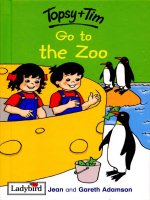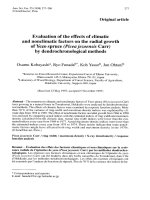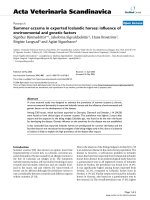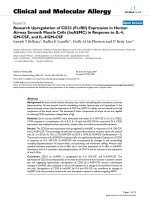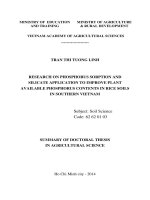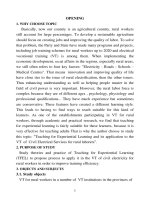Research effects of environmental and ecological factors to the distribution of some rare plant species in xuan thuy national park, nam dinh province
Bạn đang xem bản rút gọn của tài liệu. Xem và tải ngay bản đầy đủ của tài liệu tại đây (452.41 KB, 58 trang )
THAI NGUYEN UNIVERSITY
UNIVERSITY OF AGRICULTURAL AND FORESTRY
TRAN THI CHIEN
RESEARCH EFFECTS OF ENVIRONMENTAL AND ECOLOGICAL
FACTORS TO THE DISTRIBUTION OF SOME RARE PLANT SPECIES
IN XUAN THUY NATIONAL PARK, NAM DINH PROVINCE
BACHELOR THESIS
Study Mode
: Full - Time
Major
: Environmental Science and Management
Faculty
: International Training and Development Center
Batch
: K43 – AEP
THAI NGUYEN, 30/09/2015
DOCUMENTATION PAGE WITH ABSTRACT
Thai Nguyen University of Agriculture and Forestry
Degree Program
Bachelor of Environmental Science and Management
Student name
TRAN THI CHIEN
Student ID
DTN1153411090
Research effects of environmental and ecological factors to
Thesis Title
the distribution of some rare plant species in Xuan Thuy
National Park, Nam Dinh Province.
Supervisor (s)
A/Prof. Hoang Van Hung
Abstract
Nowadays, the issue of biodiversity conservation is an interested issue of countries
worldwide, particularly ecosystems in conservation areas or National Parks. Mangrove
ecosystem is one of the diverse ecosystems and most abundant. It has a tremendous role in the
economic development of a country. Besides the role supply forest product, mangrove plants
have a role in the conservation of coastal tropical region, maintain the rich nutrient source to
ensure the development of some species in the mangroves. It controls climate, expansion
alluvial area, and limit erosion. Under the influence of the weather conditions, the
development of the economic and social activities, the ecological environment such as: the
vegetation, canopy cover, fresh vegetation cover, salinity of sea water, tide amplitude…
mangrove ecosystem has suffered tremendous impact. That has influenced the development of
flora, especially rare plant species are needing protection. With many different methods such
as: Collect information, identifying information about the plant, selected plots research, we
have listed rare plant species. Based on the fact identified, we have launched a number of
appropriate measures for the conservation of rare plant species in general and in particular
biodiversity of species such as: policy solutions, technical and economic solutions.
Key words
Biodiversity conservation, ecosystems, mangrove,
Ecological environment, diversity, rare plant, National Park.
Number of pages:
59
Date of submission:
30/9/2015
i
ACKNOWLEDGEMENT
In the process of implementing the research topics: “Research effects of
environmental and ecological factors to the distribution of some rare plant species in
Xuan Thuy National Park, Nam Dinh Province”. I got the guide and help,
encouragement of the teachers and the students. I would like to express sincere
gratitude to:
First and foremost, I wish to express sincere thanks to the Director Board of
Thai Nguyen University of Agriculture and Forestry, board of managers of
International Training and Development Center and all the teachers have dedicated
teaching, the scientific knowledge and the valuable experience for me during the
training period, learning in school.
In particular, I take this opportunity to express profound gratitude and deep
regards to the supervisor A/Prof. Hoang Van Hung, who guided wholeheartedly, to
advise, imparted knowledge and valuable experience help me during the study and
completed thesis.
I also would like to express my gratitude to the Management Board and staff
officers Xuan Thuy National Park in Giao Thuy District, Nam Dinh Province has
helped me during practice, the actual investigation to completion this thesis.
Finally, I would like to express our gratitude to the family, relatives and friends
who have helped me during the internship. Due to the short time, limited professional
qualification and less experience the report may have inevitable mistakes. I very much
look forward to the valuable inputs and recommendation of teachers and friends to my
thesis more perfect.
Thank you very much!
Thai Nguyen, 30/09/2015
Student
Tran Thi Chien
ii
TABLE OF CONTENTS
LIST OF FIGURES ............................................................................................... 1
LIST OF TABLES ................................................................................................ 2
LIST OF ABBREVIATIONS ............................................................................... 3
PART I. INTRODUCTION .................................................................................. 4
1.1.Research rationale ...............................................................................................4
1.2. Research’s objectives .........................................................................................5
1.2.1. General objective ............................................................................................5
1.2.2. Specific objective ............................................................................................5
1.3. Research questions and hypotheses ...................................................................6
1.4. Significance........................................................................................................6
1.5.Limitations …………………………………………………………………….6
PART II. LITERATURE REVIEW ...................................................................... 7
2.1. Scientific basis of topics ....................................................................................7
2.1.1. Related Concepts ............................................................................................7
2.1.2. The conventions concerning threatened species .............................................8
2.2. The legalbasis………………………………………………………………..............10
2.2.1. The text of Central ........................................................................................10
2.2.2. The texts related to the Xuan Thuy National Park, Nam Dinh Province. ....11
2.3. Factual basis and reasoning .............................................................................11
2.3.1. The influence of environmental factors to the flora in the world .................11
2.3.2. The influence of environmental factors to the flora in Vietnam ..................13
2.2.3. Introduction to Xuan Thuy National Park, Nam Dinh Province ..................14
iii
PART III. METHODS ........................................................................................ 16
3.1. Material ............................................................................................................17
3.1.1. Object of study ..............................................................................................17
3.1.2. Location and Time of the research ...............................................................17
3.1.3. Research contents..........................................................................................17
3.2. Research Methods ............................................................................................18
3.2.1. Methods of collecting data, analysis and synthesis of secondary data .........18
3.2.2. Methods for ditermining information about the vegetation and ecology
should collect……………………………………………………………………..19
3.2.3. Choices and establish research plots .............................................................19
3.2.4. Collect information .......................................................................................19
3.2.5. Processing data..............................................................................................20
3.2.6. Data analysis .................................................................................................20
3.2.7. Method: Investigate plants following the lines. ............................................20
PART IV. RESULTS .......................................................................................... 22
4.1. Assessment of natural conditions of the Xuan Thuy National Park, Nam Dinh
Province ..................................................................................................................22
4.1.1 Geographical location ....................................................................................22
4.1.2. Topographic characteristics ..........................................................................23
4.1.3. Land characteristics ......................................................................................24
4.1.4. Climate characteristics ..................................................................................26
4.1.5. Tidal characteristics, hydrology and sedimentation rate ..............................27
4.1.6. Advantage and disadvantage.........................................................................28
iv
4.2. Socio-economic characteristics affect biodiversity conservation in Xuan Thuy
National Park, Nam Dinh Province ........................................................................28
4.2.1. Population, labor and employment ...............................................................28
4.2.2. Economic development situation ..................................................................30
4.2.3. Infrastructure .................................................................................................30
4.2.4.Culture affects indigenous plants in Xuan Thuy National Park, Nam Dinh
Province ..................................................................................................................31
4.3. Assessment of the status of biodiversity in Xuan Thuy National Park, Nam
Dinh Province ................................................................................................. 32
4.3.1. Diversity ecosystems of Xuan Thuy National Park, Nam Dinh Province... 32
4.3.2. Diversity of plant species in Xuan Thuy NP, Nam Dinh Province ............ 32
4.3.3. Species composition of phytoplankton .................................................... 34
4.3.4. Scientific value and practicality of the flora in Xuan Thuy NP ......... 34
4.4. The distribution of vascular plants occurs in the research area..................... 35
4.4.1. The relationship between ecological and environmental factors in 5
standard plos………………………………………………………………..38
4.4.2. The relationship between the plants in 5 plot research .............................. 40
4.4.3. Resources endemic plants and rare trees .................................................. 42
4.5. Proposed solutions to conserve, maintain the flora of Xuan Thuy National
Park, Nam Dinh Province ................................................................................ 43
4.5.1. Policy solutions ...................................................................................... 43
4.5.2. Management solutions ............................................................................ 43
v
4.5.3. Technical solutions ................................................................................ 44
4.5.4. Economic solutions ................................................................................ 44
PART V. DISCUSSION AND CONCLUSION................................................. 45
5.1. Discussion ........................................................................................................45
5.2. Conclusion .......................................................................................................46
REFERENCES .................................................................................................... 49
vi
LIST OF FIGURES
Figure 4.1: Map of Xuan Thuy National Park...............................................................22
Figure 4.2: The relationship between the ecological and environmental factors with the
distribution of flora in Xuan Thuy National Park. ........................................................38
Figure 4.3: Rate uniformity of ecological factors in the standard plots ........................39
Figure 4.4: The relationship between species appears in 5 plots research. ...................40
Figure 4.5: The relationship between the plants in 5 plots research
in Xuan Thuy NP ...........................................................................................................41
Figure 4.6: The relationship between the 5 plots based research of species .................41
1
LIST OF TABLES
Table 4.1: The area of natural land areas in Xuan Thuy National Park ........................25
Table 4.2: Statistics of all soil type in Xuan Thuy National Park .................................26
Table 4.3: Area, population and population density of the buffer zone ........................29
Table 4.4: Statistics area of ecosystem types in Xuan Thuy National Park ..................32
Table 4.5: The number of plant species found in coastal mangrove areas....................32
Giao Thuy District .........................................................................................................32
Table4.6: Botanical ingredients are useful in Xuan Thuy National Park,.....................35
Nam Dinh Province .......................................................................................................35
Table 4.7: The list of species appear in all standard plot research ................................35
in XuanThuy National Park ...........................................................................................35
Table 4.8: A number of rare plant species in Xuan Thuy National Park ......................42
2
LIST OF ABBREVIATIONS
Abbreviations
CBD
Ha
IUCN
Meaning
Convention Biological Diversity
Hectare
International Union For Conservation of Nature
NH
New Hampshire
NP
National Park
3
PART I. INTRODUCTION
1.1. Research rationale
Vietnam is located in the belt tropical monsoon climate along with the diverse
topography has made high biological diversity. That made Vietnam become one of the
few countries in the world has ecosystems mangrove coastal very unique of wetland.
The role and significance of economic, social, environment mangroves have been
confirmed in several studies and in practice not only in our country but all over the
world, especially where there are mangroves. Thereby, shows the importance of the
ecosystem this potential. The economic value of mangroves is to provide food,
medicine, feed for livestock, timber, firewood, coal, oil and many other raw
materials. Regarding environment, mangrove fixed mudflats estuary expand plain
rapidly encroaching sea, combat coastal erosion and the banks of rivers and canals
in coastal areas, protecting of levee system coastal, prevent salt water, climate
regulation coastal areas, mangrove forests are ideal habitats for mammals, water
birds live in mangrove areas.
To learn more about the rare species in the mangrove areas, subjects chose
research location is the National Park (NP), Xuan Thuy - Nam Dinh in Giao Thuy
District, Nam Dinh Province, where recognized 50th Ramsar site in the world and the
first in South East Asia in 1989. It has the total area about 7,100 hectares, including
3.100 hectares of well-forested land and 4.000 hectares mangroves forest land.
According to statistics, the national park is 182 vascular plant species, including
many species of algae have high economic value.
In plant species, 14 species of woody, of which there are 6 species involved in
mangroves concentration such as River mangroves, Grey & white mangroves, Large4
leafed orange mangrove, Corky stilt mangrove, Casuarinas … Composition more
diverse small woody species and grass species.
Plant composition of Xuan Thuy National Park is relatively poor compared to
many other national parks in the country, but has implications for biodiversity
conservation in wetland areas, fixed sandbanks, mudflats, breakwater and protection
activities agriculture and fisheries.
There have been many domestic and foreign projects are done in the NP.
However, there isn't thesis to study and fully statistic of biodiversity, particularly
systematic study on the effects and correlation of environmental and ecological factors
to the distribution of plant species, as the basis for biodiversity conservation strategy in
the NP.
From the urgency above, us to conduct research: “ Effects of environmental
and ecological factors to the distribution of some rare plant species in Xuan Thuy
National Park, Nam Dinh Province”.
1.2. Research’s objectives
1.2.1. General objective
Identify some ecological and environmental factors impacts to the distribution
of some plant species in the Xuan Thuy National Park.
1.2.2. Specific objective
+ Assessment of the status plant biodiversity at Xuan Thuy National Park.
+ Identify relationships between ecological and environmental factors for the
distribution of some rare plants in Xuan Thuy National Park.
+Proposed solutions to conserve biodiversity of plant species in Xuan Thuy
National Park.
5
1.3. Research questions and hypotheses
1. What is current status of plant biodiversity at Xuan Thuy National Park?
2. How do ecological and environmental factors affect the distribution of some
rare and precious species in Xuan Thuy National Park?
3. What is the conservation measure biodiversity of plant species in the Xuan
Thuy National Park?
1.4. Significance
+ The significance in learning and scientific research: Helping students have the
opportunity to approach with how to performing a scientific research project, helped
me applied the knowledge learned into practice..
+ The significance in practice: Research equipped for students the basic
knowledge about the environmental and forest ecosystems, made me understand
more about the biodiversity of our country as well as their localities. From which
helping region oriented measures for conservation and maintain of some rare plant
species in the future
1.5. Limitations
This study can’t include all the management problems of plant species in the
park. Because the study was done in a short time, the thesis is limited by many
factors in the process of survey and investigation of the diversity of plant species in
the study area.
6
PART II. LITERATURE REVIEW
2.1. Scientific basis of topics
2.1.1. Related Concepts
Ecosystem: Ecosystem is a community of living organisms in conjunction with
the nonliving components of their environment (things like air, water and mineral
soil), interacting as a system.
Biodiversity: Biodiversity is the abundance and diversity of life, has a vital role
on Earth. Biodiversity has many great values, focus on three groups: economic values,
humane values and ecological values. (Gaston and Spicer, 1998).
+ Economic value is to provide food, only food for humans. According to
calculations of scientists around the world, annually, biodiversity gives people a
product output worth 33,000 billion.
+ Human values of biodiversity is richness, colorful beauty of nature, provide
aesthetic value.
+ Value ecological role is to maintain biological balance, protect resources,
climate regulation and decomposition of waste.
National Park: NP is an area on land or at sea, no or just slightly affected by
human activities, there are rare plant and animal species and endemic or has a range of
beautiful landscapes national or international.
The goal NP is protected:
+ Protect the ecosystems and species of rare plants have national importance
and international.
+ Science research.
+ To develop ecotourism.
7
Extinction: The concept of extinction has many different meanings. A species
is considered extinct when no particular individuals of that species to survive
anywhere in the world. A species that only some individuals surviving thanks to the
care and rearing of humanity, so it is considered extinct in the wild. A species is
considered locally extinct if it does not survive in places where they lived, but people
still find them in other places in nature.
The mangroves: Mangroves are forest growing in marshy land, saline wetlands
of the estuary, the coast, along the rivers and canals have brackish water tidal risen and
fall daily. Mangrove formed by the mangroves if the cover of over 10%. This forest
consists of mangrove species orthodoxy, these are the only species in the mangroves,
theses plants can be found in both the mangroves and other areas.
2.1.2. The conventions concerning threatened species
International Convention is writing, stating what to follow and what is
prohibited implementation, involving a certain field by a group of countries with
commitments agreed upon and implemented, in order to create a common voice, unity
of action and cooperation in member countries.
Vietnam has participated and signed a lot of international agreements related to
the Convention on Biological Diversity.
• Conservation of threatened species:
Convention on Biodiversity (CBD) is a program of the United Nations
Environment (UNEP) has drafted since 1988, undergo many meetings and discussions
between the countries since 1992, at an international conference on environmental and
development in Rio (Brazil), 168 countries have signed the Convention and
implemented in dated November 28, 1994. The Convention on Biodiversity includes
8
the preamble, 42 articles and two appendices. Vietnam has signed the Convention on
Biodiversity on May 10, 1994 and became the 99th member of the convention. All
contents of the convention made three main objectives:
+ Protect Biodiversity.
+ Sustainable use of biodiversity.
+ Profit distribution of new products derived from wild species and
domesticated species.
• Cites Convention ( Convention on International Trade for plants and animal
wild species have be endangered).
Cites convention was signed through dated March 1, 1973, effective from dated
July 1, 1975 in Washington. Contents of Cites are member countries implementing the
prohibition on trade of wild animal and plant species international, which are
threatened with extinction listed in the appendix attached to the convention.
• International Union for Conservation of Nature
International Union for Conservation of Nature (IUCN) was established to
target to influence, encourage and assist organizations throughout the world to
conserve the integrity and diversity of nature, ensure the use of natural resources
sustainable and equitably ecologically. Vietnam has become a country member of
IUCN since 1993.
• Ramsar Convention on wetland areas
Ramsar Convention is an international convention for the conservation and
rational uses of an appropriate and wetland area, purpose to prevent the increasing
encroachment on wetland areas as well as the loss of them in this time as well in the
future, recognizing the ecological function of the platform and the values wetland
areas of entertainment, science, culture and our economy.
9
2.2. The legal basis
2.2.1. The text of Central
Biodiversity Law 2008 provided for the conservation and sustainable
development of biodiversity, the rights and obligations of organizations, households,
citizen in conservation and sustainable development of biodiversity.
Environmental Protection Law dated November 29, 2005.
+ Law on Protection and Development of forest (effect from dated August 1, 2005).
+ Fishery Law promulgated in 2003.
+ Decree No. 32/2006 / ND-CP dated November 30, 2006 on forest vegetation
management, endangered animals, rare-Law Environmental protection dated
November 29, 2005.
+ Decree No. 80/2003 / ND - CP dated August 9, 2006 of the Government
stipulating in detail and guiding the implementation of some provisions of
environmental protection law.
+ Decree No. 117/2009 / ND-CP on handling violations of law in the field of
environmental protection.
+ Decree No. 32/2006 / ND-CP dated March 30, 2006 about managing the
forest flora and fauna endangered, rare and precious.
+ Decree No. 48/2002 / ND-CP dated April 22, 2002 amended list of plants,
rare wildlife.
+ Decree No.109/2003 / ND-CP on the conservation and sustainable
development of wetlands in Vietnam.
+ Decision 04/2004 of the Ministry of Natural Resources and Environment
approved an action plan for the conservation and sustainable development of wetlands
period 2004- 2010.
10
2.2.2. The texts related to the Xuan Thuy National Park, Nam Dinh Province.
+ Decree No.48 / CP dated August 12, 1996 of the Government on sanctioning
administrative regulations in the field of protection of aquatic resources.
+ Decision No. 01/2003 / QD-TTG on Xuan Thuy conversion of wetland
protected areas converted into Xuan Thuy National Parks, Nam Dinh Province.
+ Decision No. 04/2004 / QD NRE April 5, 2004 by the Minister of Natural
Resources and Environment approved a plan of action on conservation and sustainable
development of wetland areas for 2004 to 2010.
2.3. Factual basis and reasoning
2.3.1. The influence of environmental factors to the flora in the world
The crisis of species of plant and wildlife, even worse financial crisis and global
recession today. That is the warning from the deputy director of animal programs of
conservation group Biodiversity International Federation of nature conservation
(IUCN) G. Cry VI-XTOP when his analogy here is the time to recognize that nature is
the largest "company" is the world's profitable100% of humans. Yet nature is being
devastated to serious consequences for the environment.( G. Cry VI-XTOP, 1997).
The plants and animals make up the magic of wildlife have a specific role and
contributions are essential for human life, such as providing food, medicine, oxygen,
water and balance ecosystem. Climate change leads to habitat changes and the fauna
and flora must also change the growth cycle and the physical characteristics or alter
migratory routes to adapt to the new environment, undermines the biodiversity.
According to a recent study of international biodiversity, scientists warned more
than a third of the world's animal species in danger of extinction. In addition 47 677
species in Red list, a most authoritative assessment of some countries of the species
11
on Earth has endangered and are based on research by thousands of scientists, today
17.291 species are threatened, of which 21% are mammals, 30% of amphibians, 70%
of plants and 35% invertebrates. The amphibian species are groups of organisms most
seriously affected on the word, with 1.895 among 6.285 species in the list threatened.
Of these, 39 species extinctions, 484 species at risk high extinction, 754 species
threatened, 657 species are not protected (Twinkle and colleagues, 1992). The
scientists warned the world not to fear the species at risk high extinction, but also
threatened, breaking completely ecosystems. The numbers on the alarm-risk species
disappear forever though leaders world have pledged to take action to reverse that
trend.
The Convention on Biodiversity (CBD) came into force in 1993 made three
goals: conservation of biodiversity; to use biological diversity in a sustainable way;
benefit sharing of biodiversity in a fair manner. Currently, 168 countries have signed
on, which aims to 2010 significantly reduced rate of biodiversity loss at the global
level, regional and national levels. However, according to conservationists, mankind
has not conducted sufficient measures to prevent major threats.
Environmental pollution, climate change leading to the gradual loss of habitat
of the fauna and flora, one of the main causes leading to the loss of biodiversity. Loss
of habitat affects 40% of mammals, IUCN Director, Ms. G. Mat warning, is the
scientific evidence for a serious extinction crisis. The loss of biodiversity most serious
occurred in Central and South America; East, West and Central Africa, especially in
Madagascar, South and East-South Asia (Ms. G. Mat, 1994). Loss of biodiversity is
one of the most serious crisis the world as the number of species decreased to low.
12
African countries warned that the ecosystem of the continent most vulnerable to
shocks world of weather. Famine, water scarcity, desertification status, reduced
agricultural productivity caused human quality of life in Africa is low. Africa accounts
for about a fifth of the global land area and about a fifth of the plants, mammals and
birds in the world, accounting for one-sixth of amphibians and reptiles. About a fifth
of the birds in southern Africa have seasonal migration in Africa and one in ten
migrants between Africa and other continents of the world.
2.3.2. The influence of environmental factors to the flora in Vietnam
Drought occurs in most areas of the country, average annual temperature
increased by 0, 1 and 0, 30 ° C / decade. Temperature increase and rainfall changed
that will affect agriculture and water resources. Sea levels likely rise one meter by the
end of the century, then Vietnam will take over 12% of land area, the residence of 23%
of the population.
The consequences of global climate change cause more clearly, including
impacts on biodiversity, valuable resources of the country. Based on some research
done in the world and the natural conditions of Vietnam, forecast consequences of
climate change will impact on the Mekong Delta and Hong Delta, the coastal area and
the system forest ecology in the country. Sea level rise will affect the wetland coast of
Vietnam, the most serious is the mangrove area in Ho Chi Minh City, Vung Tau
Province and Nam Dinh Province.( Nguyen Hoang Tri and colleagues, 2002).
Two deltas and coastal in our country, including mangroves and wetland system
are very rich in species, are very vulnerable ecosystems. Sea level rise along with the
intensity of storms will change the composition of the sediment, salinity and pollution
levels of water, degrade and threaten the survival of mangroves and species in dirty.
13
As sea levels rise, about half of the 68 wetlands will be affected, saltwater will
penetrate deep into the mainland, killing many species of freshwater plants, affecting
freshwater supply for drinking and cultivation of many areas, 36 protected areas,
including eight national parks , 11 natural reserves will be flooded. ( Phan Nguyen
Hong and colleagues, 1999). The marine ecosystem will be hurt, the coral reef is the
habitat of many marine species, are the shield wave against coastal erosion and protect
mangroves would escape the risk of being degraded by heat rising sea. Temperature
increase to make the source seafood dispersed. The tropical fish species increased,
subtropical fish species (high economic value) decreases.
The environmental changes taking place will threaten developing, threaten the
lives of all species, ecosystems. Climate change and its consequences such as floods,
droughts, forest fires, erosion and landslides will promote faster biodiversity
degradation, exacerbated, especially tropical forest ecosystems is not intact, increases
the risk of extinction of animals and plants, make you disappear, genetic resources,
rare and emerging diseases can arise. Climate change increases the risk for some
patients, changes characteristic in circadian rhythms of humans. According to the
World Health Organization (WHO), global warming is likely to make more than 150
thousand people dead and five million people suffer from various diseases. The above
figure may be doubled by 2030.
2.2.3. Introduction to Xuan Thuy National Park, Nam Dinh Province
On May 1, 1989 alluvial estuary in Xuan Thuy District was officially
recognized joined the Ramsar Convention by UNESCO (Convention for the Protection
of wetlands of international importance, especially as internally displaced resident of
water bird). This has become a member of the world's 50th Ramsar, first in Southeast
14
Asia, Vietnam's most exclusive for 16 years. On December 12/2004, UNESCO
continues recognized biosphere reserve coastal intercity of Hong River Deltas, in
which Xuan Thuy National Park is core area has a special importance of the biosphere
reserves world.
Xuan Thuy National Park represents the wetland ecosystem typical estuary in
Northern Vietnam. When Xuan Thuy National Park is a Nature Reserve
simultaneously carries many other international honors, where would have been a lot
of advantages.
Considered by many sectors and institutions in domestic and international
concern, units which have organized, implemented various scientific and technological
activities, community development activities and ecotourism.
Xuan Thuy National Park has characteristic ecosystem:
+ Ecosystem evergreen tropical rain, the wind edaphic type mangroves daily,
this vegetation type distribution center in Con Lu and Con Ngan covers a large area
of the park has an area 1.589ha. Species composition mainly is river mangroves, holly
mangroves, gray & white mangroves, thick vegetation intertwined, ecosystems have
two main cum laude union:
_ Laude union river mangroves, Holly mangroves, gray & white mangroves,
this laud union are distributed in the North of the NP.
_ Laude union pure forest plantations distribution center in the South of the Park.
+ Ecosystem evergreen forest tropical rain, soil subtype daily mangrove, this is
a place to shelter, overnight, nesting, feeding of birds and their habitats as well as
species of otter fish, aquatic, amphibian, reptile.
15
+ Ecosystem subtypes soil. This vegetation type occupies 182ha area,
distributed northern geese of Con Ngan and a small part of Con Lu.
+ Ecosystem dunes land and dune sandy is a kind of empty land occupied
636ha area of the Park, distributed mainly in Con Xanh and Con Lu.
+ Ecosystem dumps alluvial muddy sediment: focuses on Con Ngan, Ba Lat
estuary, the dump south of the Vop estuary. It is about 596ha. This is where the
development of the species of clams, fish, crabs, and feeding habitats of water birds.
+ Ecosystem casuarinas forest was planted on the narrow strip of sandy land
near the beach in the east.
+ Ecosystem creeks river water surface and sea water: The density of water
covers a large area of the NP (4,000 hectares), which is an ecosystem with high
biodiversity including:
_The water surface of rivers and creeks: including water surface of the Hong
River, Tra River, Voc River and narrow passages formed by them. This is the habitat
of water birds: geese, mallards, storks, kingfishers, hawk… foraging inshore.
_The sea water surface is calculated from the depth under 6 meters, this is
inhabited and is feeding habitats for birds and fishes.
Species diversity of Xuan Thuy National Park:
Cording to statistics, the national park is 182 vascular plant species, including
many species of algae have high economic value. Class dicotyledonous has species,
genera and family is the most, 123 species (accounting for 67.4% of total species).
( According to statistics of Phan Hong Anh and colleagues, 2004).
16
PART III. METHODS
3.1. Material
3.1.1. Object of study
The ecological and environmental factors affect the flora forest in Xuan Thuy
National Park NP, Nam Dinh Province.
3.12. Location and Time of the research
Location: Xuan Thuy National Park, Nam Dinh Province
Time: March 2, 2015 to June 30,2015.
3.1.3. Research contents
3.1.3.1. Investigate and assess the natural conditions of Xuan Thuy National Park,
Nam Dinh Province
+ Geographical location.
+ Climate.
+ Hydrology.
+ Natural resources.
3.1.3.2. Investigate and assess the socio-economic conditions affecting biodiversity
conservation of Xuan Thuy National Park, Nam Dinh Province
+ The population.
+Economy.
+ Infrastructure.
+ Education, health of local people.
+ Economic conditions and other social effects to National Parks.
+ Indigenous culture relating to the use and protection of natural resources.
17
3.1.3.3. Investigate and assess the status biodiversity of Xuan Thuy National Park,
Nam Dinh Province.
+ Diversity ecosystems: coastal ecosystems, Ramsar ecosystem...
+ Diversity of species: Endemic species, specific species of mangrove water...
+ Diversity of populations.
3.1.3.4. Determine the environmental and ecological factors affect the distribution of
the flora in Xuan Thuy National Park, Nam Dinh Province
+ Ecological factors: The vegetation, canopy cover, fresh vegetation cover, litter...
+ Impacting from other factors: road distance, the distance near residential
areas, the devastation...
+ The geographical factors: Location research, altitude, coordinates...
+ Other factors.
3.1.3.5. Determine the distribution of high vascular plants appear in the research area
+ Determine the frequency of occurrence of vascular plant species on plots research.
+ Determine the classification plant species: order, family, genus, species.
+ Determine the species composition.
3.1.3.6. Proposed solutions to conserve, maintain the flora in Xuan Thuy National
Park, Nam Dinh Province
+ Technical solutions.
+ Policy solutions.
+ Economic solutions.
3.2. Research Methods
3.2.1. Methods of collecting data, analysis and synthesis of secondary data
Method of collecting data, analysis and synthesis of secondary documents is a
common method, often used when we researched a theme. This is the reference
18

